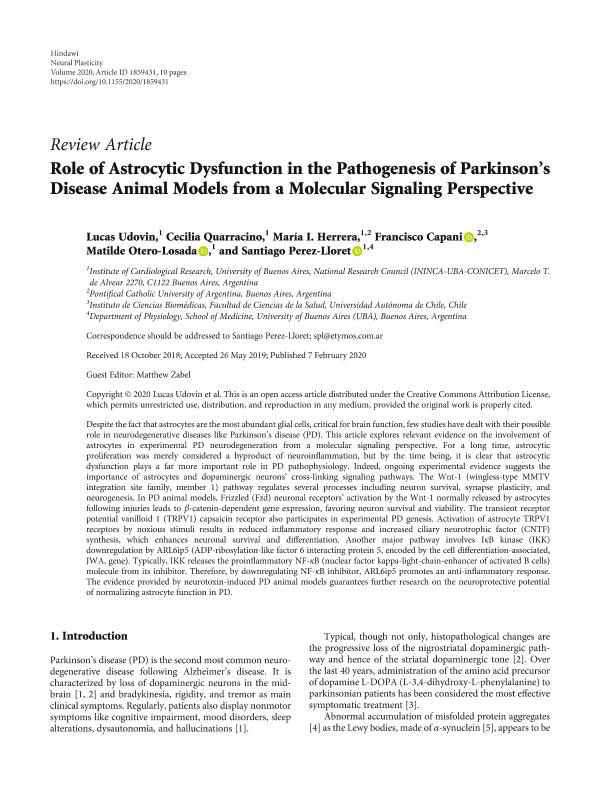Artículo
Role of Astrocytic Dysfunction in the Pathogenesis of Parkinson's Disease Animal Models from a Molecular Signaling Perspective
Udovin, Lucas ; Quarracino, Cecilia
; Quarracino, Cecilia ; Herrera, María Inés
; Herrera, María Inés ; Capani, Francisco
; Capani, Francisco ; Otero-losada, Matilde Estela
; Otero-losada, Matilde Estela ; Perez Lloret, Santiago
; Perez Lloret, Santiago
 ; Quarracino, Cecilia
; Quarracino, Cecilia ; Herrera, María Inés
; Herrera, María Inés ; Capani, Francisco
; Capani, Francisco ; Otero-losada, Matilde Estela
; Otero-losada, Matilde Estela ; Perez Lloret, Santiago
; Perez Lloret, Santiago
Fecha de publicación:
02/2020
Editorial:
Hindawi Publishing Corporation
Revista:
Neural Plasticity
ISSN:
2090-5904
Idioma:
Inglés
Tipo de recurso:
Artículo publicado
Clasificación temática:
Resumen
Despite the fact that astrocytes are the most abundant glial cells, critical for brain function, few studies have dealt with their possible role in neurodegenerative diseases like Parkinson's disease (PD). This article explores relevant evidence on the involvement of astrocytes in experimental PD neurodegeneration from a molecular signaling perspective. For a long time, astrocytic proliferation was merely considered a byproduct of neuroinflammation, but by the time being, it is clear that astrocytic dysfunction plays a far more important role in PD pathophysiology. Indeed, ongoing experimental evidence suggests the importance of astrocytes and dopaminergic neurons' cross-linking signaling pathways. The Wnt-1 (wingless-type MMTV integration site family, member 1) pathway regulates several processes including neuron survival, synapse plasticity, and neurogenesis. In PD animal models, Frizzled (Fzd) neuronal receptors' activation by the Wnt-1 normally released by astrocytes following injuries leads to β-catenin-dependent gene expression, favoring neuron survival and viability. The transient receptor potential vanilloid 1 (TRPV1) capsaicin receptor also participates in experimental PD genesis. Activation of astrocyte TRPV1 receptors by noxious stimuli results in reduced inflammatory response and increased ciliary neurotrophic factor (CNTF) synthesis, which enhances neuronal survival and differentiation. Another major pathway involves IκB kinase (IKK) downregulation by ARL6ip5 (ADP-ribosylation-like factor 6 interacting protein 5, encoded by the cell differentiation-associated, JWA, gene). Typically, IKK releases the proinflammatory NF-κB (nuclear factor kappa-light-chain-enhancer of activated B cells) molecule from its inhibitor. Therefore, by downregulating NF-κB inhibitor, ARL6ip5 promotes an anti-inflammatory response. The evidence provided by neurotoxin-induced PD animal models guarantees further research on the neuroprotective potential of normalizing astrocyte function in PD.
Archivos asociados
Licencia
Identificadores
Colecciones
Articulos(ININCA)
Articulos de INST.DE INVEST.CARDIOLOGICAS (I)
Articulos de INST.DE INVEST.CARDIOLOGICAS (I)
Articulos(SEDE CENTRAL)
Articulos de SEDE CENTRAL
Articulos de SEDE CENTRAL
Citación
Udovin, Lucas; Quarracino, Cecilia; Herrera, María Inés; Capani, Francisco; Otero-losada, Matilde Estela; et al.; Role of Astrocytic Dysfunction in the Pathogenesis of Parkinson's Disease Animal Models from a Molecular Signaling Perspective; Hindawi Publishing Corporation; Neural Plasticity; 2020; 2-2020; 1-10
Compartir
Altmétricas



